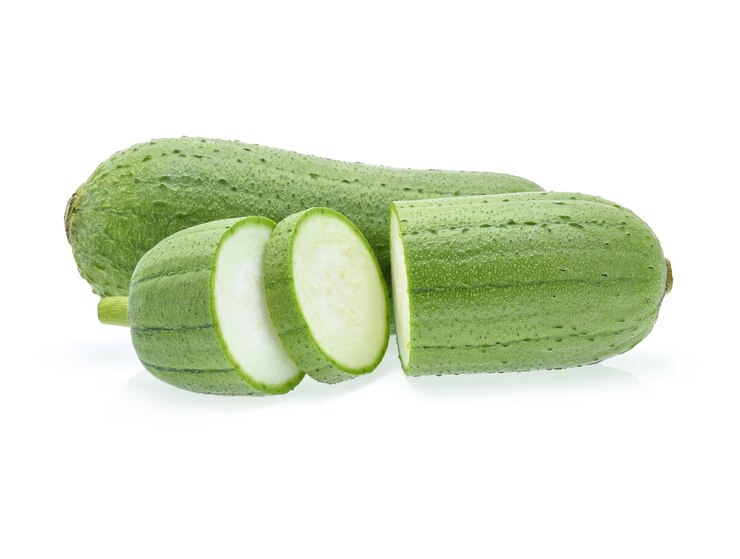

Luffa cylindrica (L.) M.Roem.
|
It is commonly known as Ghia and belongs to the family Cucurbitaceae. It is an annual climber cultivated for its fruits used as vegetables. It contains chemical components which have effects on hypersensitivity reactions, serve as immunostimulant, and an anti-inflammatory agent. Oleanolic acid isolated from L. cylindrica demonstrated inhibition of NO production at 10 μM in an LPS/IFN-γ-induced cell model. Mode of Consumption : Fried and cooked |
| Plant Details | Agro-climatic Zone | Vernacular Names | Pictures |
| Scientific Name: Luffa cylindrica (L.) M.Roem. Family: Cucurbitaceae Juss. Class: Magnoliopsida Order: Cucurbitales Genus: Luffa Mill. Fruiting Season: May to August Parts: Fruit |
|
Andhra Pradesh : Neyangnattakolu Assam : Bhul Bihar : Nenua Karnataka : Tuppaheere, Tipri Maharashtra : Palo Mizoram : Nawhfe-awmpawng Nagaland : Mepfu Uttar Pradesh : Ghia torai |
 Sliced fruit |
| Compound/Extract | Activity | Mode of Action | Marker/References |
| Ethanolic extract, Ethyl acetate extract of peel | Anti-inflammatory | Study on RAW 264.7 murine macrophage cells revealed that the ethanolic extract mitigated secretion of PGE2. All the extracts significantly inhibited IL-6 production, but remained ineffective in retarding generation of IL-1β and TNF-α. Ethyl acetate extract of peel reduced expression of iNOS, but enhanced expression of COX-2. | PGE2, IL-6, IL-1β, TNF-α, iNOS, and COX-2[1] |
| Ethyl acetate extracts of peel and pulp | Anti-inflammatory | Both ethyl acetate extracts of peel and pulp mitigated the expression of p-IκBα, while the ethyl acetate extracts of pulp attenuated expression of p-ERK. | p-IκBα and pERK[1] |
| Saponins | Potential Antiviral candidate | Molecular docking showed that isolated component saponins from L. cylindrica could have been used in the prevention and treatment of SARS-CoV-2. | [2] |
| Oleanolic acid | Anti-inflammatory | Oleanolic acid isolated from L. cylindrica demonstrated inhibition of NO production at 10 μM in an LPS/IFN-γ-induced cell model. | NO[2] |
| Peel and pulp extract | Anti-inflammatory | The peel and pulp extracts significantly inhibited IL-6 production in RAW 264.7 cells. | IL-6[3] |
| Micronized and nonmicronized peels | Anti-inflammatory | The concentrations of WBC, nitric oxide, cytokines GPT, IL-1β, NF-κB and PGE2 was reduced upon feeding of micronized and nonmicronized luffa peels to BALB/c mice. | NO, GPT, IL-1β, NF-κB, and PGE2[4] |
| Lucyoside B | Anti-inflammatory | Inhibited NF-κB and AP-1 signaling pathways, lucyoside B restrained the transcription and translation of iNOS, IL-6 and MCP-1 to exert anti-inflammatory actions. Lucyoside B suppressed LPS-induced JNK1/2, ERK1/2 and p38 phosphorylation in a concentration dependent manner in activated macrophages. | NF-κB, AP-1, iNOS, IL-6, MCP-1, JNK1/2, ERK1/2, and p38[5] |
| Extract | Immunoboosting | The extract can protect immune organs, increase IL-2 and IFN-γ levels in the serum, and boost the proliferation activity of T lymphocytes. | IL-2 and IFN-γ[7] |
| Lucyoside B | Anti-inflammatory | Lucyoside B extracted from the fruit of Luffa cylindrica exhibited anti-inflammatory effects through subdual of proinflammatory mediators such as iNOS, IL-6 and MCP-1 at the transcriptional and translational levels coupled with the production of NO. | iNOS, IL-6, and MCP-1[8] |
| Major Class | Metabolites (Content of bioactives: mg/100g Fresh Weight) |
| Amino Acid | 1-O-(4-hydroxybenzoyl)-glucose (Pulp): , 1-O-caffeoyl-b-D-glucose (Pulp): , 1-O-feruloyl-b-Dglucose (Pulp): , 1-O-p-coumaroyl-b-D-glucose (Pulp): , Apigenin-7-O-b-D-glucuronide methyl ester (Pulp): , Arginine: 9750 mg/100g, Diosmetin-7-O-b-D-glucuronide methyl ester (Pulp): , Histidine: 2210 mg/100g, Isoleucine: 3580 mg/100g, Leucine: 5350 mg/100g, Luteolin-7-O-b-D-glucuronide methyl ester (Pulp): , Lysine: 5080 mg/100g, Methionine: 2140 mg/100g, Phenylalanine: 4200 mg/100g, Threonine: 2260 mg/100g, Valine: 4190 mg/100g[1] |
| Carboxylic Acid | Caffeic acid: , Chlorogenic acid: , Gallic acid: , p-coumaric acid: [8] |
| Carotenoid | Neoxanthin: , β- Carotene: [8] |
| Flavonoid | Apigenin-7- glucuronide luteolin-7-O-β-D-glucuronide methyl ester: , Catechin: [8] |
| Pentacyclic triterpenoid/sapogenin | Gypsogenin: [1] |
| Saponin | Aegyptinin-A: , Aegyptinin-B: [1] |
| Terpene | Cucurbitacin B: [8] |
| Triterpenoid | Echinocystic acid: , Oleanolic acid: [1] |
| Triterpenoid Saponin | Lucyoside A-M: , Lucyoside B: [8] |
| Effect | Observation | DOI |
| Disease | Formulation | Reference | Author | TKDL |
| Information from Wealth of India | Reference |
|
CSIR(1962).The Wealth of India, Raw materials,Vol.-VI ,P.179-181, New Delhi, India |
| 4.2, 04.2.1, 04.2.1.1, 04.2.1.3, 04.2.2.3, 04.2.2.5, 04.2.2.8 |
| CSIR-North East Institute of Science and Technology, Jorhat-6, Assam, India
CSIR-Institute of Himalayan Bioresource Technology, Palampur-61,Himachal Pradesh, India |